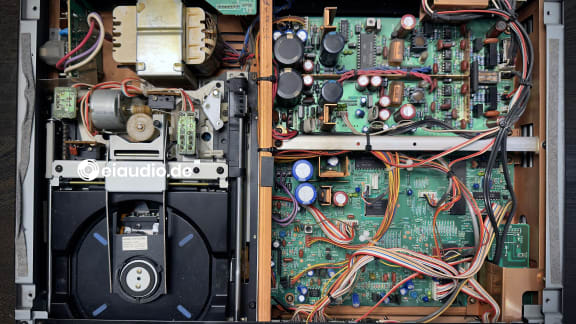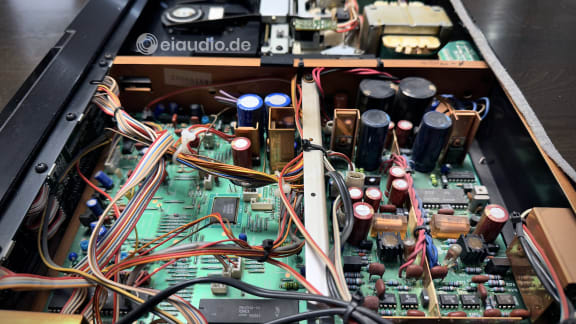Sony CDP-502ES
Published: 25/03/2023
Manufacturing date: 1984
Author: Karsten Hein
Category: Gear & Review
Tag(s): CD-Players
The CDP 502 ES was one of the early Sony CD players. It stemmed from a time in which engineers were given enormous budgets to derive what was humanly possible from their new digital audio medium. And, although Sony’s CDP 101 had been the first CD player to enter the world market, in early 1982, the company knew that they were not alone in the race. To share R&D costs and spread the risk, Sony had developed the technology in a joint venture with Philips, who were the first to launch their CD-100 in Europe in that same year. Marantz, Denon, and other manufacturers were soon to follow, and Sony had to innovate quickly in order to stay abreast of the competition. Launched in 1984, just two years after the CDP 101, the CDP 502 ES already showed many improvements over the company's first designs.
I received my test specimen from Luigi, who had purchased it from a collector along with some other audio devices. At first glance, there were no clues to betray the CDP 502 ES’s exceptionally high quality. To me, it looked like yet another CD player of the early 1980s. Black-box design with front-loading tray, lots of square buttons, an inconspicuous display, new infrared remote sensor, and headphone/output volume control. There really was nothing special in the design, until I tried lifting the Sony off the table where Luigi had placed it. Not only was it much heavier than the standard gear sold, it also seemed more rigid in its construction. I wondered if Sony had also glued lead sheets under the unit’s top plate, as I had previously seen on the Denon DCD 1500 II; however, a swift look under the hood revealed more substantial reasons for CDP 502 ES’s weight.
The front-loading drive mechanism was constructed out of machined metal blocks, instead of the already more common plastic. There was a large transformer with separate outputs for the digital and analog audio sections, as well as for the front display, and the drive and loading section. The stabilising power supply capacitors looked large enough even to serve a small amplifier. There was a copper-plated metal sheet to separate the drive unit and power supply from the audio signal section, and another sheet to separate the digital processing unit from the analog output stage. Although this was not instantly visible from the outside, the Sony engineers had taken many precautions to take audio performance to the next level. Due to its massive components and quality loading mechanism, the CDP 502 ES had the touch-and-feel of professional studio gear.
Although it was difficult for any CD player to compete with the cast-iron transport of the Philips CD 104 with sophisticated swing-arm laser paired with Rodenstock glass lenses, I must say that I preferred the smoother and more elegant feel of this Sony tray. The simple act of placing the disc on the tray felt very reassuring. I could also see how the understated design might have even highlighted this effect. There was no detectable time lag in closing the tray, and the unit offered ultra-fast pre-scan and disc access. Button commands were prompted by instant relay-switching feedback that was still audible from as far as 4 meters (!) distance. When the CDP 502 ES was in operation, one of three back-lit buttons served to indicate the play mode (Program, Shuffle, and Continuous).
The Sony offered two chinch/RCA outputs, of which one was variable via the Line Out/Headphone volume control. This feature allowed for the CD player to be integrated in a system with components of various audio output levels. I would have liked to see a digital S/PDIF output socket for added versatility and also welcomed a display-off function for additional noise reduction. However, as I had not been given the remote control along with the player, I remained unsure, if the display-off function had at all been available there. The headphone jack was of the larger 3/4-inch type, which was also my personal preference. Playback accuracy was said to be excellent due to the use of a new unilinear converter system that performed all digital signal processing in synchronisation with a single clock.
Sony proclaimed the CDP 502 ES to stand for a new generation of reference machines, and audiophiles have commented on the player’s ability to reproduce lots of musical detail while preserving the tonal warmth that was often associated with analogue equipment. Sony were also pioneers in the development of phase-correct analog and digital filters, as well as in advanced error correction that were all incorporated in the 502 design. The analog stage and output amplifiers were of a double-mono design and used Sony’s newly developed OP-amps. In many ways, the CDP 502 ES incorporated the best of CD player technology that was available at the time, and I was eager to find out how the 40-year-old unit would perform.
I hooked the CDP 502 ES up to our main system consisting of a Dynaco PAS-4 tube preamplifier and Hafler 280 XL Linear MOSFET power amplifier. The speakers were a pair of Martin Logan SL-3. The Martin Logans’s electrostatic panels were capable of reproducing even the most subtle nuances, and the Dynaco preamplifier served to assure that the overall impression was tonally rich and not overly analytical. The Hafler amp offered approximately 250 watts per channel into a 4 Ohms load and showed great low-resistance capabilities down to 1-Ohm loads. It was also known for its ultra-flat amplification well beyond the audible spectrum. Our usual CD player in this position was a Rega Planet 2000, of which it was also said that it offered an analogue-like sound.
For my listening tests, I used an assortment of Jazz and Vocal Jazz CDs, Rock, and even some Hip Hop. I wanted to find out how the CDP 502 ES would perform over a wide range of styles. From what I had seen on its circuit boards, I could imagine that the Sony would pack a punch, and I was not disappointed: The music was fast and loud with slight upper-bass emphasis. Using the fixed output cinch/RCA sockets, there was massive gain right from the very first second, and the music seemed so punchy that it bordered on overly potent. And yet, there was also an element of tight-fisted control that somehow reminded me of Denon’s DCD 1500 II, a CD player that had come out two years later.
Both the Denon and the Sony were High End players in their time, and both weighed around 9kg. A lot had been done to reign in high-frequency distortion on both of them. As a result, both machines seemed to march through the songs rather than swing though them. The resulting sound felt a little lifeless at times, and I would have wished for more freedom for the music to unfold and for individual notes to be allowed to simmer longer. The strong upper-bass presence could serve to give vocals a little more substance, which was a welcome effect. On the other hand, faster passages could at times sound a bit cluttered or congested because of it.
Piano keys did not simmer as long or resonate as low as they did on our 30-years younger Rega CD player. Low-bass extension was generally good on the Sony but not great. Despite Sony’s lead in error correction, the CDP 502 ES did not perform too well on dirty or scratched CDs. For the music to sound at its best, the discs needed to be in excellent condition. I could confirm that the 1984 Sony provided an analog and non-analytical sound experience on our system. The CDP 502 ES sounded fuller, richer, and darker than many of its competitors. Due to excessive filtering, however, some of the intrinsic flow and musicality of the performance was lost, which also took away from the believability of the music event.
Finally, I could not help but wonder, if there were available modifications for this player that would remove some of the analog and digital filter stages to uncover the beauty and power of the diamond underneath. Considering what Roman Groß ‘New Perspectives on Sound’ and ‘KR High End Laboratory’ had accomplished with the Philips CD 104, it was only fair to assume that the CDP 502 ES also had the potential of blowing most modern CD players out of the water, simply because of the impressive components that were used inside.
Specifications
- Type: Compact Disk player
- Laser principle: GaAlAs double hetero diode
- Disk revolutions per minute: 500 ~ 200 (CLV)
- Paying speed: 1.2 - 1.4 m/s
- Error correction: Sony Super Strategy
- DAC compound: 16-bit, straight line
- Frequency range: 2 - 20,000 Hz (+/- 0.3 dB)
- Harmonic distortion: < 0.0025% (1 kHz)
- Dynamic range: < 96 dB
- Wow and flutter: below measurable limits
- Line output: 2 Volts
- Headphone output: 28 mw (32 Ohms)
- Power consumption: 16 watts
- Dimensions: (W) 430mm x (H) 80mm x (D) 335mm
- Weight: 8.5 kg
- Accessories: Wireless Remote, RM-D502
- Country of manufacture: Japan
- Year(s): 1984-1987





